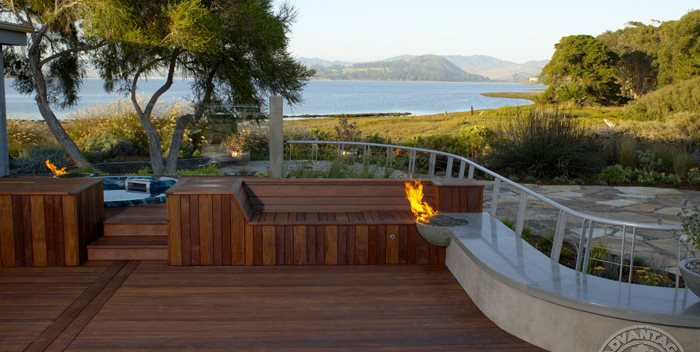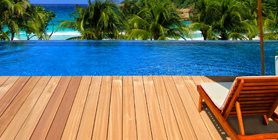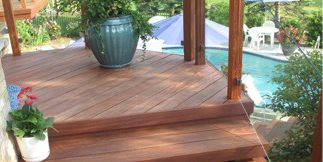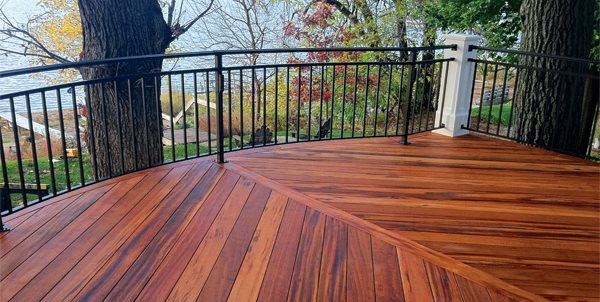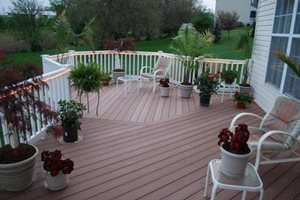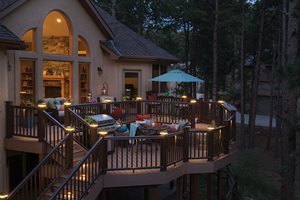Ipe Decking
Learn the pros and cons of choosing a tropical hardwood for your deckTypes of Tropical Hardwood
While ipe is the most well-known type of tropical hardwood, there are many varieties of wood that have similar characteristics of durability and beauty, yet don’t carry the same price tag. When choosing alternative varieties of tropical hardwood, you’ll still need to use stainless steel screws and carbide-tipped saw blades to work with the material.
Ipe
— Ipe is also known as Brazilian walnut and has a rich deep brown color when oiled. Ipe is the most common type of tropical hardwood, and the demand for this specific type of wood has driven up the price. It can last 30 to 50 years. Watch videos about using ipe to build wood decks.Cumaru
— Cumaru is similar to ipe in looks and density, but has a slightly more reddish tone. Ivancic says he has trouble telling cumaru and ipe apart in some settings.Tigerwood
— “It’s exactly like it sounds,” says Ivancic. “It has a reddish-orange color with black streaks, and in my eyes it’s really unique.” While tigerwood is not as dense as ipe and cumaru, it can still be expected to last more than 25 years.Garapa
— “It’s similar to tigerwood, except it has a golden yellow color,” says Ivancic. Garapa, or Brazilian ash, will last 25 years or more.Massaranduba
— Massaranduba is a Brazilian redwood with the deep red tones you’d expect from the name. It lasts more than 20 years.Ipe and other tropical hardwoods such as cumaru, tigerwood, massaranduba and garapa are a high-end, long-lasting choice for decking. The rich color of an oiled hardwood, or the pale gray when it’s weathered, look great in a modern landscape design. Here’s what you need to know before choosing a tropical hardwood for your deck.
Pros and Cons of Ipe Decking
Pros:
Color
— Oiled tropical hardwood decks have a luxe shimmer which no other material can surpass. When left to weather, the gray tone of ipe works perfectly with a modern aesthetic.Durability
— Tropical hardwoods are known for their incredible durability. They last 20 to 50-plus years, even under harsh coastal conditions. In addition, they are so dense that they do not crack, scratch, or stain easily.Variety
— If you’re not set on using ipe, there are other types of tropical hardwood with different colors or striping. These offer a price savings over ipe because they are less well-known.Low-maintenance if allowed to weather
— If you plan to let your ipe decking weather to a dull gray, you don’t need to do much to keep it looking good. Water seals are totally unnecessary and won’t even stick to tropical hardwoods, so the only care needed is to spot clean any stains that occur.
Cons:
Regular maintenance to preserve color
— Most people prefer the depthy color of an oiled hardwood, and if you want to keep that color up you need to oil the wood once a year with a UV-protectant oil. If you get behind on oiling, you can always sand the deck to uncover the color, and begin oiling regularly again after that.It’s heavy
— “You’ve got to eat your Wheaties in the morning before you install it,” says Dan Ivancic of Advantage Trim & Lumber Co. in Buffalo, NY. The density of the wood means it’s more challenging to lift and work with.Special tools
— The wood is so hard that you need to use carbide-tipped saw blades. In addition, Ivancic recommends that all screw holes be pre-drilled before installation.Stainless steel screws
— Most metals cause black oxidation stains on tropical hardwoods with prolonged contact. Ivancic recommends using stainless steel screws and fasteners, which can be a little more costly.Cost
— The biggest downside to using ipe is the expense, both initial and ongoing. “Ipe has all the cost of composite decking, with all the maintenance of wood,” says Baron Biedenweg of Archadeck of Fort Wayne in Ft. Wayne, IN.
- Pro Tip: Using hidden fasteners with tropical hardwoods is a great choice because the wood is so hard to saw or drill. Advantage Trim and Lumber sells pre-grooved deck boards which work perfectly with a hidden fastener system. Another option is to use recessed screw holes and wooden plugs for a seamless look. —Dan Ivancic of Advantage Trim & Lumber Co. in Buffalo, NY
Cost of Ipe Decking
“Ipe is the second-hardest wood in the world, but it is the most expensive due to the high demand and how well-known it is,” says Ivancic. A 1 x 6” decking board runs $3.47 per linear foot. It’s also more expensive to install than other decking options because of the reasons listed above; it’s heavy, you need special tools to cut it, and stainless steel fasteners are needed. Even so, the beauty and longevity of the material make it a popular choice, especially for contemporary homes or on the coast.
Sustainability is another factor that goes into the cost of ipe. While ordinary ipe is harvested responsibly through the Brazilian authorities, there is an organization called the Forest Stewardship Council which certifies wood as being sustainably harvested. FSC certification can drive up the cost significantly, but it’s a great option for LEED projects.
Of course, the other types of tropical hardwood will save you a little bit of money over ipe just because they are less well-known. For example, cumaru is $2.41 per linear foot, tigerwood is $2.20 per linear foot, and garapa is $2.09 per linear foot.

 Backyards
Backyards
 Front Yards
Front Yards
